Singapore Telecom
-
- NAVIGATION & COMMUNICATIONS EQUIPMENT Maritime Reporter, Mar 1991 #50
—A Review— Recent technological breakthroughs and advancements in electronics, computer-controlled systems and software, and the introduction of Inmarsat satellite communication services have led to the development of a number of new innovative marine navigation and communications products.
More powerful, more compact ARPAs, radars, integrated bridge systems, mobile satellite telephone systems, GPS plotters, EPIRBs, etc., with state-of-the-art cost-effective features continue to be introduced onto the marine market by major electronics suppliers from around the world.
In an effort to sort out some of the numerous choices, the editors of MARITIME REPORTER have asked a number of major electronics manufacturers and suppliers to report on their latest navigation and communication products. The following review is based on information received as of press time.
For More Information To receive free literature describing any of the high-tech products detailed in this review, circle the appropriate Reader Service Number listed for each company using the postage-paid card bound into the back of this issue.
AT&T AT&T recently unveiled a new family of secure telecommunications products tailored to meet the specific requirements of customers who handle sensitive but unclassified government information.
The new product line, AT&T STU-III Secure Communications Products, 2000 Series, addresses three overlapping applications in the communications security market. It embraces both secure voice and data capabilities with an innovative modular design which is easily adaptable to individual customer needs.
AT&T's STU-III 2000 Series includes a secure voice device to protect sensitive conversations, a secure data device to secure data or facsimile transfer, and a secure voice/data terminal incorporating both voice and data functions.
Each device in AT&T's STU-III 2000 Series of secure telecommunications equipment may be used by departments of federal, state and local governments, law enforcement agencies, and selected corporations and academic institutions.
For free literature detailing AT&T's STU-III, Series 2000, Secure Communications Products, Circle 62 on Reader Service Card ALDEN ELECTRONICS Alden Electronics, Westboro, Mass., is introducing the Alden Satfind- 406 EPIRB (Emergency Position Indicating Radio Beacon).
Alden's 406 EPIRB transmits the location and identity of equipped vessels in distress anywhere in the world to shore locations via the COSPAS-SARSAT orbiting satellite system. Alden's EPIRBs are available in two basic models: Category 1 features an automatic release mechanism which deploys the EPIRB before it reaches a depth of four meters. The Category 2 version is deployed manually.
The Alden Satfind-406 EPIRB contains a powerful transmitter operating at both the standard 121.5 MHz and the new 406 MHz frequencies to alert Search and Rescue personnel. Combined, Alden reports the two frequencies can reduce the search area by 20 times that which was possible with older EPIRBs.
This provides faster and more accurate location and recovery.
The Satfind-406 EPIRB meets U.S. Coast Guard, Canadian and COSPAS-SARSAT specifications and is approved for use on commercial and recreational vessels.
Armand Bouchard, manager of marine sales at Alden, stated: "The Satfind-406 EPIRB complements the Alden line of Marinefax and Faxmate recorders in that it helps assure safety at sea for commercial vessels or private yachts. Like the Marinefax and Faxmate, the Alden Satfind-406 EPIRB will be manufactured at Alden's Westboro, Mass., facility and sold through Alden's marine electronics dealer distribution network." For free literature detailing the Satfind-406, Circle 61 on Reader Service Card COMSAT COMSAT Mobile Communications, Washington, D.C., recently announced the completion of its second Inmarsat Coast Earth Station (CES) at Southbury, Conn., which now enables COMSAT to serve both the Atlantic Ocean Region- East (AOR-East) and Atlantic Ocean Region-West (AOR-West) within Inmarsat's new four-ocean region coverage area. COMSAT claims to be the only Inmarsat signatory offering this service.
COMSAT said that the additional ocean region will allow it to offer improved service that will result in greater reliability and less congestion, expanded Atlantic Ocean Region coverage, and the development of new services for maritime, aeronautical and international land mobile customers.
"Ships located in the Atlantic Ocean should decide which AOR satellite is most appropriate for their operations and then notify their shore-based contacts of the appropriate ocean code to use," said James Jancso, COMSAT Mobile Communications' vice president of operations.
Vessels operating with the AOREast satellite can be reached by dialing the 871 ocean area code before the ship's number. The AORWest ocean area code is 874. Mr.
Jancso said that if the wrong area code is dialed, callers will receive a recorded message that the ship is not operating with that satellite.
COMSAT Mobile Communications, a business unit of COMSAT Corporation is based in Washington, D.C., and provides maritime, aeronautical, and international land mobile satellite communications.
For free literature detailing the communications services of COMSAT, Circle 86 on Reader Service Card ELECTRONIC MARINE SYSTEMS Electronic Marine Systems, Railway, N.J., has introduced the "Chart Viewer," a new U.S.-made portable charting instrument. The Chart Viewer shows a precisely detailed reproduction of NOAA charts, with buoys, depth markings and drop down menus on a flat screen display. According to Electronic Marine Systems, the unit holds a complete database of all navigational aids which can be easily updated using Chart Viewer's interactive software. After connecting Loran, GPS or Satnav receivers to the Chart Viewer, it shows own ship position and movements across the NOAA charts.
For free literature detailing the Chart Viewer, Circle 63 on Reader Service Card FURUNO Furuno USA, Inc., South San Francisco, Calif., recently introduced the GP-1500 GPS navigator/ plotter, a unique combination of the company's LP-1000 track plotter and Furuno's GPS receiver technology.
The GP-1500 has a high resolution seven-inch flat screen CRT and a sophisticated second-generation dual channel receiver with eightstate Kalman filter for reliable fixes and multiplex tracking of up to five satellites. Voyage planning can be either from waypoint to waypoint, or as many as 10 different routes consisting of up to 10 waypoints each can be stored in the memory.
Memory capacity is 99 waypoints, 1,800 track points and 1,524 event marks, with four different event symbols for maximum navigation flexibility. In addition, the GP-1500 provides 600 trackpoints and 508 event marks on plug-in RAM cards and utilizes Furuno's factory digitized charts on ROM cards.
Plot scales are continuously adjustable from 0.14 to 360 nm and plot interval can be set in either time or distance units. Ship's track is calculated on two separate pages, each of which can have different range scales, and either page can be displayed at the flip of a switch.
Other standard features include autopilot output, cross-track steering indicator, 17 lines of on-screen nav data, menu-driven operation, 100- knot tracking velocity, audio/visual alarms for arrival/border/XTE, highly accurate clock/calendar, backlit tactile keyboard, and the ability to display water depth and temperature on screen with appropriate optional sensors.
The GP-1500 has an extensive self-test program and provides data input/output in both NMEA and CIF formats, as well as accommodating RS232C peripherals.
For free literature detailing the new GP-1500 from Furuno, Circle 64 on Reader Service Card HENSCHEL Henschel Inc., a subsidiary of SPD Technologies, has announced its microprocessor-based shipboard announcing systems have been selected for use aboard the next two nuclear-powered aircraft carriers, USS John C. Stennis (CVN-74) and USS United States (CVN-75). The system includes microphone stations, power amplifiers, and control panels, and provides general announcing, aviators announcing and flight deck announcing systems.
Emergency alarms are integrated into the system and include general quarters, chemical, collision, flight warning and flight crash alarms.
The Henschel announcing system is designed to electronically enhance sound quality and intelligibility under both routine and adverse ship operating conditions. In the case of aircraft carriers, increased intelligibility is necessary because of the particularly difficult acoustic conditions found in the immense hangar and flight decks of these ships.
The Stennis and the United States, under construction at Newport News Shipbuilding, will be the fourth and fifth ships to receive this system. Previously, identical systems were selected for CVNs 72 and 73, providing an excess of 15,000 watts of audio power. A smaller system is being delivered to the USNS Harkness (T-AGS-32) providing 200 watts. Regardless of system size, the Henschel systems offer full design features including: enhanced speech quality, overload protection, built-in test features, simple expandability, and modular architecture for quick repairs.
For free literature detailing Henschel products, Circle 87 on Reader Service Card HOSE-MCCANN Hose-McCann Telephone Co., Englewood, N.J., a pioneer in marine sound-powered telephones, recently celebrated its 50th anniversary as a leader in the production of safe, reliable, state-of-the-art communication systems.
This New Jersey-based corporation fills equipment needs of vessels throughout the U.S. and the world's leading maritime nations.
Hose-McCann's entire product line, which includes sound-powered telephones, navigation light panels, audible and visual signaling devices, and a full array of U.S. Navy Symbol Number Items, is manufactured and tested in accordance with the latest military specifications. Where applicable, Hose-McCann products comply with National Electrical Safety Code requirements, are accepted by the U.S. Navy and Coast Guard.
One notable product line offered by Hose-McCann is the Series 9500 telephone system, which was developed specifically for the maritime industry. The Series 9500 is a completely modular, sold-state digital system. It can provide up to 32 shore trunks and as many as 128 stations.
At sea, the Series 9500 performs as a PBX, while on shore as a PABX.
For free literature detailing the Hose-McCann product line, Circle 88 on Reader Service Card ICOM MARINE ICOM Marine, Bellevue, Wash., recently introduced a new 24-nautical mile radar, the MR-40, designed for mid-size commercial boats and recreational craft.
All required information is shown on a bright 9-inch green phosphor CRT with multiple pulse lengths.
Four selectable intensity levels let you read all indicators clearly, day or night. View up to 37 nautical miles.
With ICOM's large "Omni-Knob" selector, you can quickly move the EBL (Electronic Bearing Line), VRM (Variable Range Marker) Cursor, and range functions.
A high performance slot-array antenna, featuring a durable magnetron with stable 3 kw (PEP) output power and high sensitivity give you 24 nautical mile range. For even longer targets you can use the center shift function to expand measurement range up to 37 nautical miles.
Unlike conventional marine radars, the MR-40 gives you north-up display capability by connecting a flux gate compass sensor. Head-up display, showing your bow point direction, is also available with the touch of a button.
Even when you're not observing the CRT display, if islands, landmasses, ships or other objects enter a preset alarm zone, beep tones warn of potential collisions. You can also connect an external bell or buzzer for a louder off-bridge alarm.
For more information on ICOM's MR-40 radar, Circle 65 on Reader Service Card IDB COMMUNICATIONS Since August of 1990, IDB Communications has fulfilled the requirements of the U.S. government and the worldwide media for reliable, portable communications links from the Persian Gulf. On January 1,1991, IDB introduced yet another solution by becoming the first nonsignatory carrier to be allowed to access Inmarsat, the satellite system covering the world's four major ocean regions.
Since that time, IDB has become a major distributor of portable Inmarsat "flyaway phone" terminals to the government and media, providing equipment, satellite time, transmission service and personnel as needed for integral communications links from the Persian Gulf War.
CNN is one of IDB's major media clients in the Gulf, accounting for the highest usage by far. IDB's other "flyaway phone" clients in the Gulf include NBC, Tokyo Broadcasting System and CBS.
Each "flyaway phone" user is assigned a unique access number, the same kind of code used by ships, for indentification by Inmarsat. Signals from the Gulf are being routed via the Indian Ocean Region satellite to OTC in Perth, Australia, and then via international long-distance carriers to their end country.
IDB Communications Group, Inc., based in Los Angeles, is a lead- ship position and movements across the NOAA charts.
For free literature detailing the Chart Viewer, Circle 63 on Reader Service Card FURUNO Furuno USA, Inc., South San Francisco, Calif., recently introduced the GP-1500 GPS navigator/ plotter, a unique combination of the company's LP-1000 track plotter and Furuno's GPS receiver technology.
The GP-1500 has a high resolution seven-inch flat screen CRT and a sophisticated second-generation dual channel receiver with eightstate Kalman filter for reliable fixes and multiplex tracking of up to five satellites. Voyage planning can be either from waypoint to waypoint, or as many as 10 different routes consisting of up to 10 waypoints each can be stored in the memory.
Memory capacity is 99 waypoints, 1,800 track points and 1,524 event marks, with four different event symbols for maximum navigation flexibility. In addition, the GP-1500 provides 600 trackpoints and 508 event marks on plug-in RAM cards and utilizes Furuno's factory digitized charts on ROM cards.
Plot scales are continuously adjustable from 0.14 to 360 nm and plot interval can be set in either time or distance units. Ship's track is calculated on two separate pages, each of which can have different range scales, and either page can be displayed at the flip of a switch.
Other standard features include autopilot output, cross-track steering indicator, 17 lines of on-screen nav data, menu-driven operation, 100- knot tracking velocity, audio/visual alarms for arrival/border/XTE, highly accurate clock/calendar, backlit tactile keyboard, and the ability to display water depth and temperature on screen with appropriate optional sensors.
The GP-1500 has an extensive self-test program and provides data input/output in both NMEA and CIF formats, as well as accommodating RS232C peripherals.
For free literature detailing the new GP-1500 from Furuno, Circle 64 on Reader Service Card HENSCHEL Henschel Inc., a subsidiary of SPD Technologies, has announced its microprocessor-based shipboard announcing systems have been selected for use aboard the next two nuclear-powered aircraft carriers, USS John C. Stennis (CVN-74) and USS United States (CVN-75). The system includes microphone stations, power amplifiers, and control panels, and provides general announcing, aviators announcing and flight deck announcing systems.
Emergency alarms are integrated into the system and include general quarters, chemical, collision, flight warning and flight crash alarms.
The Henschel announcing system is designed to electronically enhance sound quality and intelligibility under both routine and adverse ship operating conditions. In the case of aircraft carriers, increased intelligibility is necessary because of the particularly difficult acoustic conditions found in the immense hangar and flight decks of these ships.
The Stennis and the United States, under construction at Newport News Shipbuilding, will be the fourth and fifth ships to receive this system. Previously, identical systems were selected for CVNs 72 and 73, providing an excess of 15,000 watts of audio power. A smaller system is being delivered to the USNS Harkness (T-AGS-32) providing 200 watts. Regardless of system size, the Henschel systems offer full design features including: enhanced speech quality, overload protection, built-in test features, simple expandability, and modular architecture for quick repairs.
For free literature detailing Henschel products, Circle 87 on Reader Service Card HOSE-MCCANN Hose-McCann Telephone Co., Englewood, N.J., a pioneer in marine sound-powered telephones, recently celebrated its 50th anniversary as a leader in the production of safe, reliable, state-of-the-art communication systems.
This New Jersey-based corporation fills equipment needs of vessels ing supplier of transmission services for radio, television, data and voice communications via satellite and fiber optics.
For free literature detailing the communications services of IDB, Circle 89 on Reader Service Card KELVIN HUGHES Over three years ago, U.K.-based Kelvin Hughes launched its new "Concept" range of navigational radar systems. At that time the "Concept" High Refresh (HR) range comprised of True and Relative motion systems with 12-inch (HR2000 R and T) or 16-inch (HR3000 R and T) monochrome displays, a full ARPA system with a 16-inch (HR3000 A) monochrome display, lOkw and 25kw " X " band and 30kw "S" band transmitters along with 1.8m. 2.4m and 3.9m antennas, turning mechanisms and interfaces for a variety of compasses.
While retaining their original specifications, including the high definition display screens, the systems have been changed. Today, the "Concept" range has been expanded and improved to contain a number of new features of benefit to the mariner. These include the introduction of a color monitor display, Electronic Switching Unit, Upmast transmitters, improved turning mechanisms and new software facilities.
Notable improvements to the Concept series include: • The Monitor Expansion Unit (MEU), which allows up to six monitors to be remote sited from the main display at convenient locations.
• The Electronic Switching Unit, which is capable of interswitching up to a maximum of six separate Concept transmitter/receiver units and six Concept radar display units.
The ESU allows for any one of the displays to become master of, and display the information from, any of the transmitter/receiver units.
• The introduction of upmast transmitters which lowers system purchase costs and installation time.
• Improvements to software facilities including Navigation Systems Interface, which enables external information from ship's navigation system to be fed into the Concept systems and displayed on screen, and External Mapping, which allows the storage of up to 200 screen generated maps.
For free literature detailing the Kelvin Hughes Concept Radar Series, Circle 90 on Reader Service Card KODEN Koden's new GTD-2200 GPS track plotter combines the accuracy and range of satellite positioning with the features and convenience of a bright, seven-color graphic display.
The built-in Koden GPS receiver features parallel processing of the signal data, which can increase reception by up to four hours a day over multiplexed systems. And it eliminates the delay built into sequential GPS receivers, so that any change in speed is instantly displayed on the screen.
It also has the unique ability to convert lat/long into their corresponding Loran TD readings.
The plotter features a high-resolution nine-inch color screen, with plug-in chart cards to display the outline of surrounding land areas.
Key positions on the chart (such as buoys, fishing equipment or navigational hazards) can be highlighted on the chart (and saved for future use), with seven different symbols, and 100 numbers per symbol for up to 700 different settable points.
For free literature detailing Koden International's GTD-2200 GPS track plotter, Circle 66 on Reader Service Card KRUPP ATLAS ELEKTRONIK New navaid developments from Krupp Atlas Elektronik include a type-approved extension to the 7600-8600 Series of Rasterscan radars, the Atlas 8600 NAV. Designed for either stand-alone or integrated use, it provides a comprehensive range of integrated radar, ARPA and navigation display functions.
In conjunction with an adaptive radar-controlled autopilot and INS configurations, the system permits automatic route planning and control functions. Selection of up to three different positioning sensors, including GPS, is also possible with direct display of lat/long grids on the radar screen. Own-ship position in lat/long is also displayed.
Up to 65 video maps of 60 elements each can be stored, and other features include manual acquisition of up to 20 targets and automatic tracking with target data readout, including CPA and TCPA. Guard zones and limitation lines for automatic acquisition and tracking of up to 40 targets can also be set.
Other new developments include an advanced bridge Nautical Consulting and Information System, the NCIS 1800. Comprising a keyboard display terminal and a series of user-oriented software modules, the system is designed for both on and off-line use. Typical applications include voyage preparation and planning, voyage monitoring and recommended procedures for emergency operations, including search and rescue; input and coding of weather data in addition to stability-monitoring computations is also possible.
For free literature detailing Krupp Atlas Elektronik's 7600-8600 Series of rasterscan radars or NCIS 1800, Circle 67 on Reader Service Card LITTON SPECIAL DEVICES Litton's Special Devices division, Springfield, Pa., has delivered its 4,000th Emergency Rescue Beacon to its exclusive sales distributor, Koden International, Inc., Norwell, Mass. The EPIRB can help rescuers to locate maritime ships, pleasure craft, fishing vessels or other vessels in distress.
The rescue beacon is a self-contained aid that can automatically transmit an emergency signal at 121.5 MHz and 406 MHz to polarorbiting satellites which relay the data to ground stations for high accuracy calculation of a craft's locations.
The rescue beacon is compactly designed, measuring 28 inches high and 12 inches in diameter and weighing 25 pounds, including the deployment mechanism.
The rescue beacon has received Canadian, Australian, and U.S. government approval for use on all marine vessels registered in their respective countries.
Litton Special Devices division is a unit of Litton's Servo Components group.
For free literature detailing EPIRBs from Litton's Special Devices division, Circle 68 on Reader Service Card L YNCSO- VALMET MARINE One of the main principles behind the Integrated Ship Control System from Lyngso-Valmet Marine Company of Denmark is to reduce the workload of the ship's crew through a high degree of computer automation.
The aim is to achieve a very high degree of safety in machinery operation, as well as navigation and lookout.
Consequently, all tasks relating to the ship's operation can be carried out with four levels of redundancy, from full computer automation through semiautomatic and hardwired operation to manual/local control.
The interface between man and machine is extremely important. An operator can control the ship's machinery from the Visual Display Unit by using the keyboard and trackball. The Visual Display Unit and keyboard are called the Ship Control Station.
Any mimic picture requested is displayed on screen, with full graphics and color. All mimic pictures are produced in a display processor, and all "activities" are shown as realtime functions.
The Integrated Ship Control System contains the autopilot, control of main engine(s), maneuver coordinator, alarm, monitoring, power management, control for ancillary machinery, as well as other required on board functions.
To integrate all the automation and navigation systems, a large amount of computer power is needed. The ISC is delivered to the shipyard in accordance with ISO 9001 QA Standards, which means that the project management is strictly controlled, with specific rules for the Factory Acceptance Test, Harbor Acceptance Test and Sea trial Acceptance Test.
For more information on Lyngso- Valmet Marine's Integrated Ship Control System, Circle 69 on Reader Service Card MAGELLAN Building on the success of its GPS NAV 1000, Magellan Systems Corporation, a leading manufacturer of GPS receivers for the boating market, has introduced the NAV 1000 Plus for commercial use.
Portable, mountable and able to be connected to a wide variety of navigation equipment, the Plus offers the next generation of NAV 1000 technology. Its innovative features maximize the accuracy of the U.S. Government's Global Positioning System (GPS).
Innovations include the Plus's delivery of rapid position updates (read-outs of current positions in latitude and longitude) by adjusting for the user's position every 2-1/2 seconds. The Plus's flexibility of use is further extended by a dataport, which allows the Plus to transmit navigation information in National Marine Electronics Association (NMEA) code (0183) to autopilots, video plotters and radar systems.
When used in conjunction with its bracket mount and external antenna, the NAV 1000 Plus offers excellent versatility—stand alone or portable GPS navigation information.
Operating as a permanent; or backup GPS receiver, the NAV 1000 Plus is lightweight, completely waterproof.
For free literature detailing Magellan equipment, Circle 70 on Reader Service Card MAGNAVOX Magnavox Advanced Products & Systems Co., Torrance, Calif., has introduced a new six-channel GPS navigation receiver which provides an extraordinary range of features.
The new Magnavox MX200 GPS Navigator is designed specially for the professional navigator, and offers the highest possible levels of navigational accuracy and reliability at a competitive price.
The multi-channel continuoustracking architecture of the MX200, according to Magnavox, provides important advantages over sequencing and multiplexing GPS receivers currently on the market. The Magnavox receiver uses six independent channels to track signals from all available GPS satellites simultaneously.
The result is faster acquisition times, more precise and responsive position and speed measurements, and better receiver sensitivity.
This translates into improved accuracy and more reliable performance.
The MX200's large, crisp backlit double super-twist LCD screen provides extraordinary brightness, resolution and contrast. It can be set for day or night-time viewing at the touch of a single button.
The MX200 uses multiple screens to show as much or as little navigational data as desired. At a glance, the navigator can view precise position information, course and speed over ground, set and drift, waypoint steering information and a visual graphic display of cross-track «irror.
The MX200 stores up to 200 waypoints and 20 different routes. You can program 20 different visual and sound alarms for conditions such as off-track and danger zones.
The MX200 is capable of receiving and processing differential navigation data from shoreside reference stations to remove various sources of error and enhance fix accuracy. In this manner, accuracies of better than 5 meters can be obtained. Differential navigation techniques are expected to be widely used in Vessel Traffic Systems and other applications where a higher degree of accuracy is required.
For further information on the MX200, Circle 7 1 on Reader Service Card MARINE SAFETY INTERNATIONAL MarineSafety International (MSI) of Kings Point, N.Y., is offering a three-day tug-barge boat handling course designed for three or four trainess. Simulator exercises have been selected to provide maximum experience in: channel keeping in wind and current: docking and undocking; handling the speical forces induced by shallow water, channel banks, passing vessels; emergency boathandling; and working in waterways with ranges. The instructor can modify the exercises or the schedule to better fit each trainee's needs and experience level.
Each course module consists of a discussion and briefing, one or more simulator exercises and a debriefing.
The objective of the course is to reduce the risk of groundings or collisions by providing captains and mates with the opportunity to practice and analyze their responses to challenging boathandling, traffic, environmental and accidental situations.
The course, which can be conducted by an MSI instructor or senior captain selected by a customer and assisted by MSI, will use a bridge simulator with tug controls, instruments, radar and communications, etc., with a full-color 240- degree azimuth, day-night visual scene. The simulator will create the feeling of a 2,200-hp tug pushing or with a 54,000-barrel barge on its hip or a 4,000-hp tug in notch with a 100,000-barrel barge. Simulated geographic areas will include both U.S. East and West Coast locations.
Courses are conducted at Marine- Safety-CAORF, U.S. Merchant Marine Academy, Kings Point, N.Y.
11024. Two sessions are available: 8 a.m.-5 p.m. daily or 3-10 p.m. daily.
To discuss full details and the most convenient dates for training, call Tom Garrigan at (516) 773- 5603, or, Circle 91 on Reader Service Card MIDLAND INTERNATIONAL A three-in-one marine alert/communicator system, model 78-400 Power Max Loud Hailer, has been introduced by Midland International, Kansas City, Mo.
The 78-400 is a high-power loud hailer and pager, eight-function fog horn and intercom all in one compact unit. The hailer function delivers 120 watts of peak power.
From its front panel, the operator can control optional speakers to sound either forward or aft, or simultaneously.
The same speakers will also amplify received voice information from another vessel or craft not equipped with a hailer.
The Fog horn/notifier is multifunctional.
Four Fog 400 Hertz alerts are available for power boat underway; power boat stopped; sailboat, fishing boat, towboat; and vessel under tow. In addition, the unit's custom computer-type microprocessor microprocessor generates "bell" sounds for Vessel at Anchor and Vessel Aground, plus a "yelping" for Coast Guard and water patrol craft; and manually controlled tone blast of any duration.
For free literature detailing Midland's 78-400 Power Max Loud Hailer, Circle 73 on Reader Service Card MOBILE TELESYSTEMS Mobile Telesystems, Inc. (MTI), Gaithersburg, Md., develops, manufactures and services a series of satellite communications terminals operating exclusively with the INMARSAT network.
MTI's customer service is backed by its worldwide service team, consisting of fully trained, authorized representatives in over 25 countries available 24 hours a day, seven days a week.
One product offered by MTI is the MCS-9120 satellite communications system. With the MCS-9120, dial any number in the world from the telephone on-board your vessel and you are connected in a matter of seconds. The transmission is instantaneous, clear and distortion-free.
In addition, any office equipment compatible with a telephone line can be used with the MCS-9120 (such as telex, facsimile or computer).
The MCS-9120 features worldwide transmission capability characteristic of short-wave radio with the privacy found in cellular telephones.
The MCS-9120 provides the capability of a fully integrated telecommunications network, customized to meet specific requirements.
For free literature detailing Mobile Telesystems' MCS-9120 satellite communications system, Circle 5 5 on Reader Service Card NAVAL ELECTRONICS Tampa, Florida-based Naval Electronics Inc.'s MK20/22 Marine TV Antenna now feeds a brand new "Head-End" amplifier system. The new 3000 series of cassette amplifiers splits the TV spectrum up into several bands. Each band has its own amplifier with a high dynamic range "AGC" automatic gain control.
This greatly improves system performance through lower noise and reduction of ghosting. A unique cascade filtering system incorporated in the 3000 series further reduces noise and the possibility of ghosting. For convenience, each amplifier "plugs in" to a cassette amplifier cabinet.
Naval Electronics has developed a computerized method of designing custom systems to meet exact customer requirements. This design service is free. Using the ship's "general arrangement drawings," and after consulting with the customer regarding special requirements, Naval Electronics' design team is able to quickly submit a proposal complete with engineering drawings, materials list and, pricing including installation if required.
On installment, Naval Electronics provides a troubleshooting diagram to help quickly isolate any faults that may occur.
In the past 15 years, Naval Electronics has become a world leader in MATV systems for use at sea. The company's antennas are in use by all NATO navies and are the replacement standard with the U.S. Navy and U.S. Coast Guard.
For free literature detailing Naval Electronics' products, Circle 74 on Reader Service Card NORCONTROL Norcontrol A.S. Horten, Norway, offers its 4th generation ARPA and Navigation system—DataBridge 2000A. It has been developed to comply with the proposed future requirements for IMO/IHO. The system is designed for the rough marine environment and employs proven state-of-the-art technology to insure high quality, reliability and performance. The Norcontrol concept of modular technology ensures flexibility and adaptability to customer specified navigation equipment and functions. Easy and safe operation is handled by "direct addressing" softkey keyboard, a high resolution color display and separate alphanumeric data display.
The DataBridge 2000A complies with international and local regulations of marine authorities and meets rules and requirements set forth by all major classification societies.
Radar picture presented on high resolution color display allowing true daylight viewing aslong with night time use. Digital signal processing significantly reduces clutter using CFAR circuitry, scan-to-scan and sweep-to-sweep correlation.
Manual and automatic tracking of 50 targets is offered. Total area tracking out to 55 nautical miles.
Dedicated keys control essential functions with less frequency used features available through a menudriven softkey system.
Navigational features include fairways, radar maps, parallel index lines, trial maneuver, position input from fixed targets and navigation receivers, drift calculation, VRM/ EBL and reference position.
Onboard system training is supported by four different built-in simulator scenarios.
DataBridge 2000A has sophisticated built-in on-line monitoring and off-line test programs as well as a full set of audible and visual alarm and monitoring functions are included.
For free literature detailing the DataBridge 2000A from Norcontrol, Circle 75 on Reader Service Card C. PLATH C. Plath, Hamburg, a division of Litton Industries, Inc., recently introduced a new generation of gyrocompass, autopilots and speed logs.
The recently introduced Navipilot V autopilot has a specially designed LCD display with plastic foil keyboard and electro-luminescent illumination complies with the latest ergonomical standards. The Navipilot V is suitable for connec- tion to a gyrocompass and magnetic compass and Loran-C/GPS, with continuous output of magnetic compass heading. In case of a gyro failure, all electronic equipment such as radar, satnav, satcom, etc., are fed corrected heading by magnetic compass.
The new Navigat XII gyrocompass is well-suited for desk console mounting on a bridge. This gyrocompass is suitable for ships of all types and provides a follow-up speed of 25 degrees per second. The master compass and power supply are delivered with prefabricated cables with plugs and terminal boards, which facilitates the installation works and saves costs. The Navigat XII also contains automatic switchover to 24V DC in case of main power failure.
For free literature detailing the Navipilot V or Navigat XII from C.
Plath, Circle 76 on Reader Service Card RH TRADING RH Trading, the dealer organization of the Radio Holland Group, offers the following new equipment: The newly FCC approved Sailor remote controlled SSB Radio, Model T-2130. This SSB is part of the new generation "Compact 2000" series of communication equipment, with the quality and performance that Sailor is known for.
This is another step in the direction of a complete GMDSS package for Sailor. Some noteworthy features of the unit are its compact, rugged construction, 250-watt PEP transmitter, programmable quick select channels and scanning facilities, multiple function remote control capability, and fully prepared for future duplex, digital selective calling, scrambling, and automatic radio telex options, which features will be available soon.
The new JMC GPS, model GP- 202, is a low priced, user friendly, five-channel multiplexed receiver system. It includes arrival and cross-track alarm features and NMEA 0183 output for Video Plotters or other navigation equipment.
Another new navigation product is the JMC F-830 Navigation Sounder, which uses eight-inch thermal paper and meets IMO specifications for shipboard navigation. The frequencies 28, 38, 50 and 200 KHz are switchable.
For free literature detailing the marine electronic equipment offered by RH Trading, Circle 102 on Reader Service Card ROBERTSON Robertson Tritech A/S acquired Disc Navigation A/S in January 1990. The original business idea behind Disc Navigation was to develop a product that could replace traditional sea charts.
Robertson believed that this acquisition would complement their manufacturing experience and that they could further develop the Disc Navigation concept. Initially, product development would be directed into two areas. One would be to incorporate updated official sea charts into Robertson's steering and navigation range of products.
Equally important, additional product development would allow the system to satisfy the requirements for fully integrated bridge systems, the so called "one-man bridge." Robertson's Disc Navigation can display approved electronic sea charts and is central to the fully integrated system. Sensors for Disc Navigation System are standard electronic instruments which also operate as stand-alone units.
On board the M/S Polar Circle, a combination cruise/research vessel operated by Rieber Shipping A/S of Bergen, Norway, the Disc Navigation System receives and displays all moving targets from two independent anti-collision ARPA radars.
In addition, the Disc Navigation System is interfaced to a gyrocompass, speed log, Decca Navigator, Loran C, GPS, wind speed and direction sensor, and an echo sounder.
It is also possible to interface the system to a Standard A or Standard C satellite communication system for automatic updating of the official sea charts.
The navigator can plan a detailed sailing route on the Disc Navigation System. The system, which checks the sailing route, continuously surveys all moving targets and automatically sounds an alarm if the distance to other vessels or their courses are about to result in a dangerous situation in relation to the planned course.
For free literature detailing Robertson products, Circle 92 on Reader Service Card SEA SEA Inc., of Mountlake Terrace, Wash., a unit of Datamarine International Inc., has introduced the SEA 330, a 300-watt single sideband radio system. Providing 1.6-30 MHz coverage, the SEA 330 SSB radio system is comprised of a stowable transceiver, the SEA 1630 antenna tuner, and up to four control terminals, all operating from a 24 volt power source.
Utilizing the same "SEAbuss" operating system pioneered in the award-winning SEA 322 SSB radio, the SEA 330 makes use of intrasystem communication accessed via control terminal keypad commands.
Display annuciators clearly illustrate radio status as system components talk back and forth, providing instant frequency and data recall.
For complete details and technical specifications of the SEA 330, Circle 79 on Reader Service Card SINGAPORE TELECOM Singapore Telecom is a provider of telecommunications services and the telecommunications authority in Singapore.
Singapore ranks as the world's 12th largest investor in INTELSAT, the 118-member global satellite communications organization. The country is also the 12th largest investor in INMARSAT, the International Maritime Satellite Organization comprising 59 members. Two satellite earth stations provide 2,180 circuits linking Singapore to 56 countries.
As a strategic location for shipping, Singapore has become a major center for maritime communications.
It is linked to the Pacific Ocean INMARSAT satellites, providing effective and economical ship-to-ship and ship-to-shore communications.
The Singapore Coast Earth Station offers automatic connection around the clock for ship-to-shore, ship-to-ship and shore-to-ship communications.
In addition to standard services like telephone, telex, Maritime telex letter, telegram, facsimile and data transmission, Singapore Telecom now has telex group call and packet switch services.
For free literature detailing Singapore Telecommunications' services, Circle 93 on Reader Service Card SIMRAD Simrad, Inc., Lynnwood, Wash., is offering Anritsu's RA-722UA and RA-723UA radar. These Anritsu radars represent the latest in radar technology. A new high-speed microprocessor provides even further improvement on Anritsu's well-established reputation for superior target detection and definition.
Some of the standard features of the Anritsu radar systems include 15-inch high-resolution monochrome display; eight-level quantization; and such target detection techniques as High Sensitivity (AVS), Echo Stretch Function, Automatic or Manual Sea Clutter (STC) Control.
The RA-722UA, which has 10 kw of power, and the RA-723UA, with 25 kw of power, feature a large 15- inch monochrome picture, with automatic or manual target plotting, off-centering of the radar picture, a guard zone with alarm, and picture expansion of a selected area.
For free literature detailing the Anritsu models RA-722UA and RA- 723UA or any other equipment offered by Simrad, Circle 54 on Reader Service Card SPERRY MARINE For over 80 years, Sperry Marine has been a leading supplier of navigation equipment to the world's merchant and naval fleets. Sperry Marine remains in the forefront of marine navigation technology with its award-winning Voyage Management System (VMS) series of advanced integrated navigation and control systems.
Sperry Marine's VMS, the heart of the company's Integrated Bridge System (IBS), provides the superior navigation performance and features required for cost-effective, safe ship operations. High performance route control, electronic chart, and command information modules provide the backbone of Sperry Marine's standard VMS.
A high accuracy position module (S-Fix) integrates all navigation position data to provide the "best fix" possible.
A Navigation Workstation (NWS) module, incorporated in the VMS command station, or installed in a stand-alone computer workstation, enhances planning and electronic chart creation and editing.
Sperry Marine's VMS satisfies all international classification group "One Man Bridge" guidelines for navigation equipment. More importantly, the VMS significantly increases the watch officer's effective command time. Whether a vessel is sailing under a traditional or one man watch the shipowner/operator and crew can be assured that their vessel's navigation safety is maximized.
For free literature detailing Sperry Marine's Voyage Management System and Integrated Bridge System, Circle 81 on Reader Service Card STANDARD COMMUNICATIONS Miniaturization has come to Standard Communications line of Horizon marine radios with the introduction of the new HX230S "shirt pocket-sized" subcompact five-watt VHF handheld radio.
The HX230S, like all Horizon scanning radios, may be programmed by the user to scan exactly the number or combination of channels desired. Or the user may push the P-scan button to give priority to channel 16 button to immediately bring it up. A large LCD display makes the selected channels easily visible.
Simple controls give the HX230S easy access to all U.S., Canadian and international channels, as well as 10 weather channels. A push button gives the user instant access to 10 weather channels. The radio also includes a special battery-saving circuit which saves vital battery life.
An optional voice scrambler is available for the Horizon HX230S for users who want communications security.
For further information on this and other Horizon marine products, Circle 82 on Reader Service Card TRIMBLE NA VIGA TION Trimble Navigation, Sunnyvale, Calif., offers the Acutis® GPS, a complete three-channel GPS receiver and antenna integrated into a weatherproof case that mounts like an antenna.
The California firm also offers the NavTrac GPS, which is built around an advanced three-channel GPS receiver and a small graphic display.
The NavTrac simplifies every aspect of navigation from positioning and steering to route planning.
The Acutis uses the industry standard NMEA-0183 output so it can interface with other plotters, chart plotters and satnavs, and can be installed within minutes. This versatility allows the Acutis to be moved from vessel to vessel. It is built around an advanced threechannel design that's capable of tracking up to eight satellites at once, even when subjected to severe acceleration.
The Acutis GPS is an economical way to upgrade to GPS navigation equipment without requiring installation of additional instruments or learning a new system.
The NavTrac GPS comes standard with differential GPS capability, course and speed functions which can be custom configured, a new graphic GPS satellite coverage screen, and a display which shows all satellites in view relative to your position.
The NavTrac is now available in five languages including French, German, Japanese, Spanish and English.
For European users, a Decca coordinate conversion system is also standard.
For free literature on these and other Trimble Navigation products, Circle 94 on Reader Service Card WATERCOM Since service to the inland marine industry began in 1986, WATERCOM has installed hundreds of telephone fax and data units on vessels navigating America's inland waterways.
John G. Smith, WATERCOM's vice president, sales and service, said, "Companies are increasingly discovering that WATERCOM gives better communications capabilities and costs them less than marine operators. That translates to better bottom line profits regardless of the size of the towing operation." With WATERCOM, callers dial numbers directly; there is no need for an operator to complete the call.
Waiting to make connections is virtually eliminated, and the system offers improved clarity and privacy.
It also offers modem and facsimile data transfer capabilities.
Business calls are billed on an itemized usage statement. Personal calls made by crew members must be made collect, billed to a third party or charged to a credit card.
The company never sees a bill for them. Incoming calls are the dialing party's responsibility.
WATERCOM is reportedly the only direct dial, delay free, continuous communications system on the water. The system serves more than 4,000 miles of America's waterways.
For free literature detailing WATERCOM's services, Circle 83 on Reader Service Card WESMAR Bothell, Washington-based West- ern Marine Electronics (WESMAR) offers the SS390 Series Video Sounder/ Sonar, combining the benefits of vertical sounding with 360-degree underwater scanning. These units have true stabilized soundomes, according to the company, that allow gravity to hold the transducer in place against pitch and roll. WESMAR's is said to be the only video sounder that has a stabilized transducer.
The soundome is installed through the hull, which allows much longer ranges and greater display resolution.
According to WESMAR, the SS390 scans vertically below a vessel like conventional depth sounders, but, unlike other units, it plumbs waters from 25 to 1,300-foot depths with equal clarity. Sea bottom conditions can be determined by colors alone—greens and yellows being soft, oranges and reds being hard to rocky.
In sonar mode, the SS390s scan in a 360-degree radius at any angle.
This is of particular advantage when making way through new waters— you don't have to wait until an obstacle is dangerously beneath the boat to see it. You can search ahead and to the sides for good anchorages, fish habitats and navigation.
For more information about WESMAR's SS390 Video Sounder/ Sonar, Circle 84 on Reader Service Card
-
- NAVIGATION & COMMUNICATIONS Maritime Reporter, Mar 1992 #64
with automatic or manual target plotting, off-centering of the radar picture, a guard zone with alarm, and picture expansion of a selected area. SINGAPORE TELECOM Circle 26 on Reader Service Card Singapore Telecom, which provides Inmarsat-A services to the Pacific Ocean Region via the Sentosa Coast
-
 )
March 2024 - Marine Technology Reporter page: 45
)
March 2024 - Marine Technology Reporter page: 45launched EM2042 multibeam echo sounder (MBES), allows Unique to boost its subsea equipment rental pool. The order will swell the capacity of Unique’s Singapore base, giving customers in South East Asia fresh access to the calibration free µPAP SSBL sys- tems and the lightweight, robust and user-friendly
-
 )
April 2024 - Maritime Reporter and Engineering News page: 38
)
April 2024 - Maritime Reporter and Engineering News page: 38new dual fuel lique? ed natural gas (LNG)-powered containerships: Quetzal, Copan, Tiscapa and Torogoz. The 1,400 TEU ves- sels were ordered in 2022 by Singapore-based Eastern Paci? c Shipping (EPS) for scheduled delivery from South Korea’s Hyundai Mipo Dockyard in 2025. EPS will charter the ships out
-
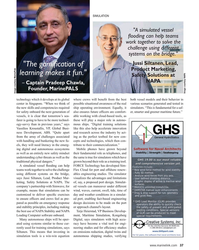 )
April 2024 - Maritime Reporter and Engineering News page: 37
)
April 2024 - Maritime Reporter and Engineering News page: 37courtesy NAPA technology which it develops at its global where crews will bene? t from the best both vessel models and their behavior in center in Singapore. “When we think of possible situational awareness of the real various scenarios generated and tested in the new skills and competencies required
-
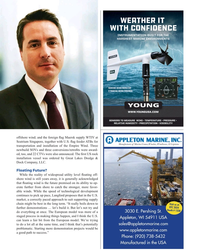 )
April 2024 - Maritime Reporter and Engineering News page: 23
)
April 2024 - Maritime Reporter and Engineering News page: 23offshore wind; and the foreign ? ag Maersk supply WTIV at Seatrium Singapore, together with U.S. ? ag feeder ATBs for transportation and installation of the Empire Wind. Three newbuild SOVs and three conversions/retro? ts were award- ed, too, and 22 CTVs were also announced. The ? rst US rock installa
-
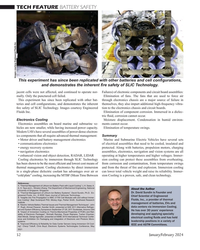 )
January 2024 - Marine Technology Reporter page: 52
)
January 2024 - Marine Technology Reporter page: 52with Liquid Cooling”; L.H. Sawa, A. A. O. Taya and L. Winston Zhang; The Department of Mechanical Engineering, National About the Author University of Singapore, Singapore Dr. David Sundin is Founder and 2. “Thermal Management of Lithium-Ion Battery Systems”, David Sundin, Ph.D. En- gineered Fluids, Inc
-
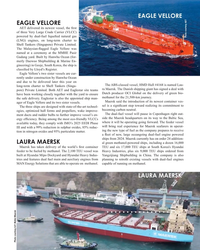 )
December 2023 - Maritime Reporter and Engineering News page: 39
)
December 2023 - Maritime Reporter and Engineering News page: 39Very Large Crude Carrier (VLCC) powered by dual-fuel lique? ed natural gas Photo courtesy AET (LNG) engines, on long-term charter to Shell Tankers (Singapore) Private Limited. The Malaysian-? agged Eagle Vellore was named at a ceremony at the MMHE Pasir Gudang yard. Built by Hanwha Ocean (for- merly
-
 )
November 2023 - Maritime Reporter and Engineering News page: 64
)
November 2023 - Maritime Reporter and Engineering News page: 64in strategic locations to sup- strategically located branches in North America, Europe and port our customers which is why we have been a go-to solu- Singapore with more than 330 maritime professionals. tions provider in the maritime industry for over 48 years. No W&O is a global source for actuated valves
-
 )
November 2023 - Maritime Reporter and Engineering News page: 8
)
November 2023 - Maritime Reporter and Engineering News page: 8OTM 705.9 33 Tidewater Offshore Operations 689.7 49 (By Country) United States of America 8,386.2 894 Norway 3,319.1 216 Brazil 3,257.6 248 Singapore 2,754.9 483 China 2,571.0 450 Top OSV Buying Companies (Spend) Buyer Company Spend ($) # Vessels Tidewater Marine 596.7 38 Britoil Offshore
-
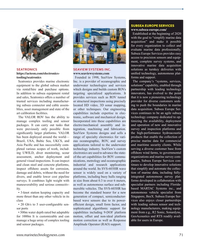 )
September 2023 - Marine Technology Reporter page: 71
)
September 2023 - Marine Technology Reporter page: 71the standard bearer for a new autonomous vehicle specialist from more thrust than any other vehicle in its generation of compact, semiconductor- Singapore, BeeX. Subsea Europe Ser- class based wave sensors due to its power- vices also enjoys closer partnerships • 20 Gb/s to 5 user-con? gurable sen-
-
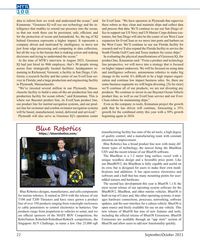 )
September 2023 - Marine Technology Reporter page: 22
)
September 2023 - Marine Technology Reporter page: 22release of BlueOS Extensions. BlueOS RoboNation RoboSub/RoboBoat/RobotX competitions, the Extensions are available through an “app store” section of Singapore AUV Challenge, to name a few. Our 25,000 sqft BlueOS and allow users to add new functionality quickly. 22 September/October 2023 MTR #7 (18-33)
-
 )
September 2023 - Maritime Reporter and Engineering News page: 59
)
September 2023 - Maritime Reporter and Engineering News page: 59by dual-fuel lique? ed natural gas (LNG) engines, Corporation. Built by San Jac Marine, Kirby’s shipyard in on long-term charter to Shell Tankers (Singapore) Pri- Channelview, Texas, Another Kirby company Stewart & Ste- vate Limited. The Malaysian-? agged Eagle Vellore was venson Manufacturing Technologies
-
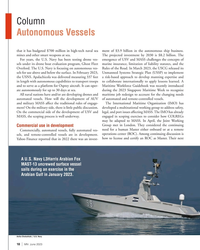 )
June 2023 - Marine News page: 18
)
June 2023 - Marine News page: 18for Osprey aircraft. It can oper- Maritime Workforce Guidebook was recently introduced ate autonomously for up to 30 days at sea. during the 2023 Singapore Maritime Week to recognize All naval nations have and/or are developing drones and maritime job redesign to account for the changing needs automated
-
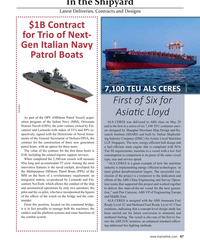 )
August 2023 - Maritime Reporter and Engineering News page: 47
)
August 2023 - Maritime Reporter and Engineering News page: 47Secretariat of Defence/DNA, the ing Industry Company (DSIC) for Asiatic Lloyd Maritime contract for the construction of three new generation LLP, Singapore. The new, energy-ef? cient hull design and patrol boats, with an option for three more. a fuel-ef? cient main engine that is compliant with NOx
-
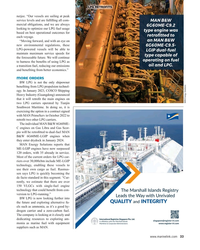 )
August 2023 - Maritime Reporter and Engineering News page: 33
)
August 2023 - Maritime Reporter and Engineering News page: 33carrier and a zero-carbon fuel. The company is looking at it closely and m|;um-?om-?!;]bv|ub;v"bm]-rou;|;l|7l dedicating resources to exploring am- [email protected] bm-L?b-?om?b|_|_;-uv_-??v?-m7v monia as marine fuel with equipment -ub?l;sourou-|;7lbmbv|u-|ouv www.register-iri.com suppliers
-
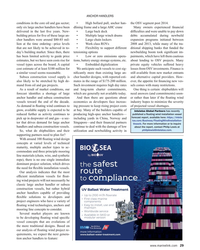 )
August 2023 - Maritime Reporter and Engineering News page: 29
)
August 2023 - Maritime Reporter and Engineering News page: 29in deepwater oil and gas—a sec- including yards in China, Norway and tus.com/Business/FloatingWindInstallation- tor that drives demand for large anchor Singapore—and their ? nancial partners Vessels. For more information or to inquire handlers and subsea construction vessels. continue to deal with the damage
-
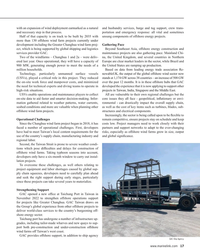 )
June 2023 - Maritime Reporter and Engineering News page: 17
)
June 2023 - Maritime Reporter and Engineering News page: 17and diving teams to operate in developed the experience that it is now applying to support other high-risk situations. projects in Taiwan, India, Singapore and the Middle East. USVs enable operations and maintenance players to collect All are vulnerable to their own regional challenges but the on-site
-
 )
May 2023 - Marine Technology Reporter page: 43
)
May 2023 - Marine Technology Reporter page: 43Many aspects of this project are being handled by separate manufacturers and installers, each with expertise relative to the oil and gas sector. The ZMAX-Planova consortium is acting as the integrator, pulling all of this expertise together to deliver a completed network for Petrobras. Of course
-
 )
May 2023 - Marine Technology Reporter page: 42
)
May 2023 - Marine Technology Reporter page: 42CABLING PIONEER CONSULTING ing and permanent reservoirs monitoring. Fiber optic cables branching units with OADM technology to deliver 200 Gb/s also help to create a safer operating environment with a more of bi-directional communications to each cable landing stations connected workforce and more ?
-
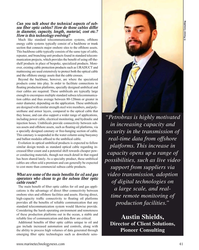 )
May 2023 - Marine Technology Reporter page: 41
)
May 2023 - Marine Technology Reporter page: 41Can you talk about the technical aspects of sub- sea ? ber optic cables? How do these cables differ in diameter, capacity, length, material, cost etc.? How is this technology evolving? © Pioneer Consulting Much like standard telecommunication systems, offshore energy cable systems typically consist of a
-
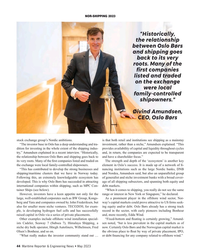 )
May 2023 - Maritime Reporter and Engineering News page: 44
)
May 2023 - Maritime Reporter and Engineering News page: 44. “When it comes to shipping, you really do not see the same However, investors have a keen appetite not only for the range or interest in New York or Singapore,” he declared. large, well-established corporates such as BW Group, Kongs- As a prominent player in the offshore wind sector, Nor- berg and Yara
-
 )
April 2023 - Maritime Reporter and Engineering News page: 42
)
April 2023 - Maritime Reporter and Engineering News page: 42courtesy Incat Crowther Following a successful initial loading operation and maid- en voyage on the river Rhine, Covestro and HGK Shipping Singapore’s Majestic Fast Ferry Pte welcomed the ar- GmbH put into service the new low-water vessel Courage at rival of three new Incat Crowther-designed
-
 )
February 2023 - Maritime Reporter and Engineering News page: 36
)
February 2023 - Maritime Reporter and Engineering News page: 36base. Globally Chris-Marine has eight companies, with its head- quarters in Sweden and a physical presence in China, Den- mark, Ecuador, Germany, India, Singapore and the U.S. “[Before the pandemic] it was easier to convince a customer to pay for us ? ying from Copenhagen to Mozambique, or Siberia or Shanghai
-
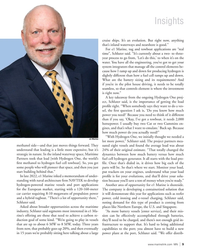 )
February 2023 - Marine News page: 9
)
February 2023 - Marine News page: 9. noting demand for this type of product is coming from Asked about broader opportunities across the maritime places like Northern Europe, the U.S. and Singapore. industry, Schluter said segments most interested in e1 Ma- “As more battery vessels [enter service], and their mis- rine’s offering are those that
-
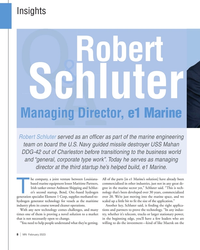 )
February 2023 - Marine News page: 8
)
February 2023 - Marine News page: 8Insights Robert QQQQQQQQQQAAA & Schluter Managing Director, e1 Marine Robert Schluter served as an of? cer as part of the marine engineering team on board the U.S. Navy guided missile destroyer USS Mahan DDG-42 out of Charleston before transitioning to the business world and “general, corporate
